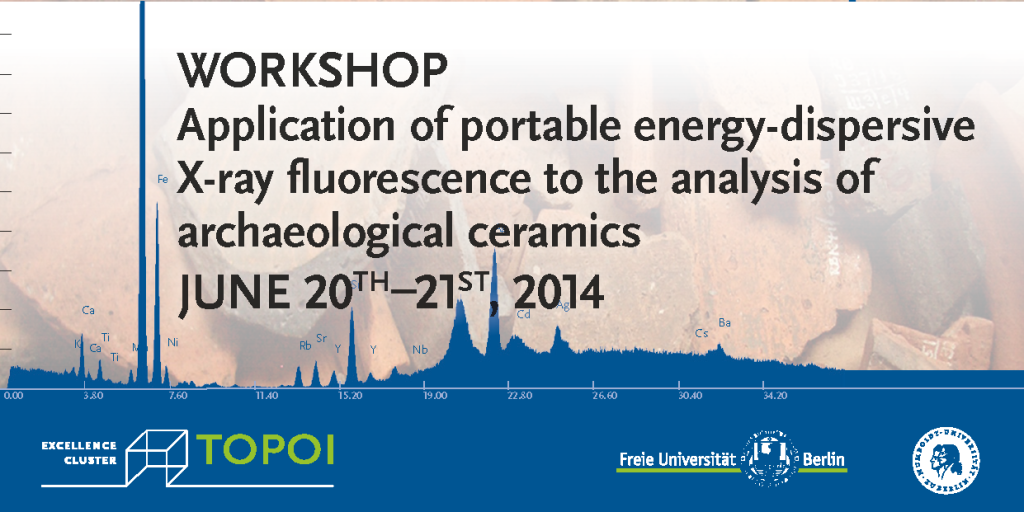The application of portable energy dispersive X-ray fluorescence analysis (p-ED-XRF) enables a large number of measurements to be made quickly, thus providing new opportunities for multifaceted analysis of ceramic materials, especially of surfaces. In this workshop the contributions outline the results of a basic research examining the correlation of various analytical techniques. We will exchange experiences on analysis of ancient pottery and glass compared to other analytical techniques (e.g. wavelength dispersive XRF) and to ceramological techniques (e.g. macroscopic fabric analysis, MGR-analysis). Measurement on surfaces vs. measurement of fresh breaks as well as precision, accuracy and archaeological interpretation of data will be discussed with various projects.
20.6.2014 | |
10:00 - 10:30 | Introduction to the Topoi‐projects on economic spaces Michael Meyer |
10:30 - 11:00 | Methodological developments in p‐ED‐XRF and comparison with other analytical techniques Oliver Mecking |
11:00 - 11:30 | Coffee |
11:30 - 12:00 | Analysis of clay tablets using p‐ED‐XRF and a portable microscope Yuval Goren |
12:00 - 12:30 | Surface analysis of sherds of Nabatean pottery and experiments with gypsum moulds Ewa Bobryk Małgorzata Daszkiewicz |
12:30 - 13:00 | Non‐destructive and destructive provenance determination using p‐ED‐XRF and WD‐XRF Gerwulf Schneider |
13:00 - 14:00 | Lunch |
14:00 - 14:30 | Evaluation and calibration of the Tracer (Bruker) for classifying pottery from the middle Euphrates in comparison with WD‐XRF‐results Antonia Hofmann |
14:30 - 15:00 | p‐ED‐XRF analysis as a method in economic archaeology: some case studies of its application Markus Helfert |
15:00 - 15:30 | Testing the p‐ED‐XRF on ceramic materials: time, space and statistical evaluation Anders Lindahl |
15:30 - 16:00 | Coffee |
16:00 - 16:30 | Testing the groups ‐ Exploring the application of p‐ED‐XRF in provenance studies of transport amphorae from the Eastern Aegean Anno Hein |
16:30 - 17:00 | Some comments on the application of p‐ED‐XRF: technical ceramics and beyond Thilo Rehren |
17:00 - 17:30 | Protocols and strategies for ceramic analysis by pXRF: in pursuit of archaeological relevance Elisabeth Holmqvist‐Saukkonen |
17:30 - 18:00 | Coffee |
18:00 - 18:30 | Analysis of beads from Gala Abu Ahmed (Sudan) using p‐ED‐XRF and XRD Małgorzata Daszkiewicz Miriam Lahitte Rudolf Naumann |
18:30 - 19:00 | Application of p‐ED‐XRF in analysis of blue painted pottery from Amarna (Egypt) Anne Seiler |
21.6.2014 | |
09:30 - 10:00 | Macroscopic analysis of fabrics and p‐ED‐XRF in studying Moesian sigillata Marcin Baranowski Gerwulf Schneider |
10:00 - 10:30 | Determination of provenances of sigillata finds in Scotland Richard E. Jones |
10:30 - 11:00 | Classification of Bronze Age pottery from Cornesti‐Iarcuri (Romania) Małgorzata Daszkiewicz Bernhard Heeb |
11:00 - 11:30 | Coffee |
11:30 - 12:00 | Cluster analysis of chemical data vs. matrix classification by refiring: example of Imperial period wheel‐thrown pottery from Olbia, Ukraine Małgorzata Daszkiewicz Andrea-Fleur Schweigart |
12:00 - 12:30 | From univariate to multivariate clustering with application to p‐ED‐XRF data Hans-Joachim Mucha |
12:30 - 13:00 | Analysis of glass using p‐ED‐XRF Joachim Lutz Ernst Pernicka |
13:00 - 14:00 | Lunch |
14:00 - 14:30 | Analyses of glass from Comariv (Ukraine) using p‐ED‐XRF and WD‐XRF Małgorzata Daszkiewicz Hans-Jörg Karlsen (geb. Nüsse) |
14:30 - 15:00 | p‐ED‐XRF applied to soil and sediment studies Philipp Robert Hoelzmann |
15:00 - 16:00 | Discussion |

